
Aiwnios
A HolyC Compiler/Runtime for 64bit ARM/X86
Stars: 89
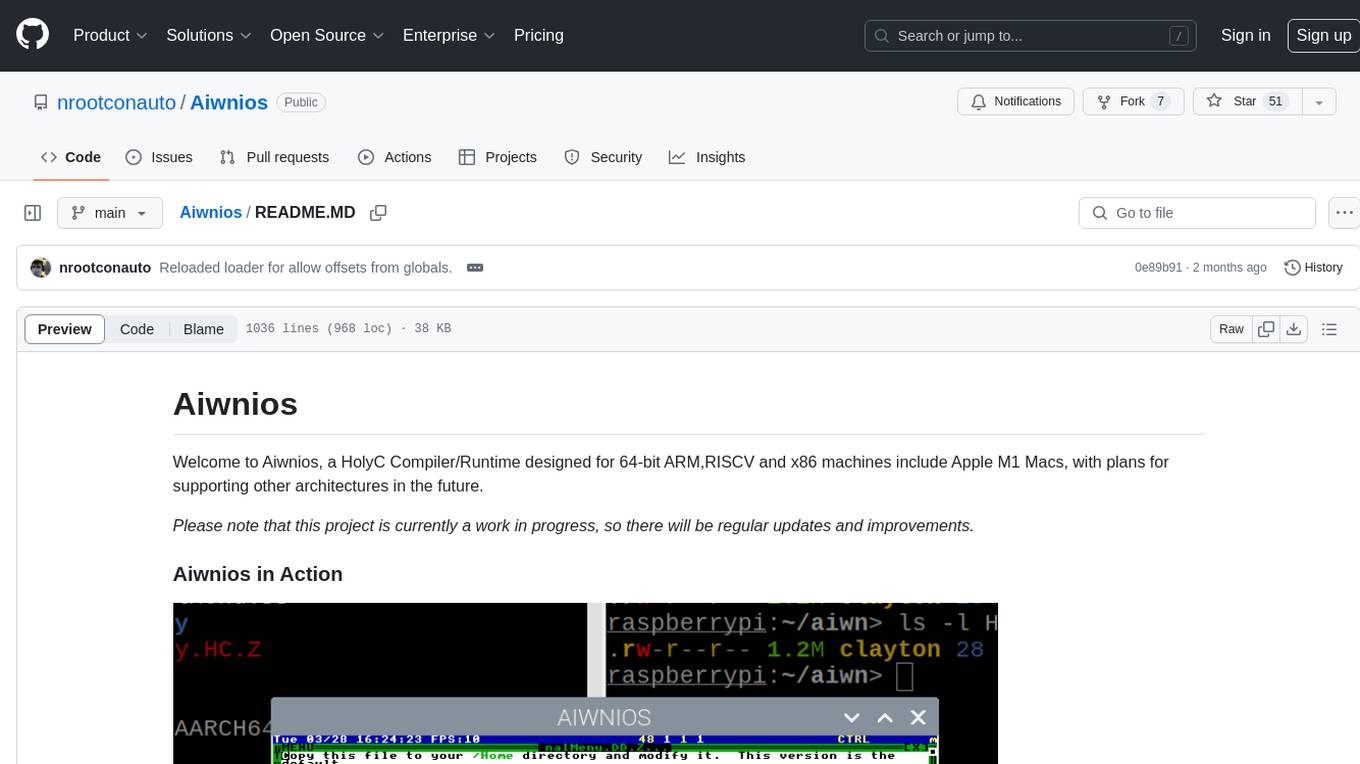
Aiwnios is a HolyC Compiler/Runtime designed for 64-bit ARM, RISCV, and x86 machines, including Apple M1 Macs, with plans for supporting other architectures in the future. The project is currently a work in progress, with regular updates and improvements planned. Aiwnios includes a sockets API (currently tested on FreeBSD) and a HolyC assembler accessible through AARCH64. The heart of Aiwnios lies in `arm_backend.c`, where the compiler is located, and a powerful AARCH64 assembler in `arm64_asm.c`. The compiler uses reverse Polish notation and statements are reversed. The developer manual is intended for developers working on the C side, providing detailed explanations of the source code.
README:
This is a HolyC Compiler/Runtime written for 64bit x86, aarch64 (includes MacOS) and RISC-V machines,although other architectures are planned for the future. This project is largely complete (aside from adding support for other architectures) so stay tuned.
| Architecture | OS |
|---|---|
| x86_64 | Windows, Linux and FreeBSD |
| aarch64 | Linux, FreeBSD and MacOS |
| rv64 (RISC-V 64) | Linux |
I develop on a lot of computers. For ARM I use an Apple M1 MacBook(MacOS x Asahi Linux). For RISC-V I use a LicheePi4. Make sure you buy one Trump imposes tariffs on sexy RISCV machines(I also test on a StarFive VisionFive 2). For X86_64 I use alot of old and new machines.
To build Aiwnios, you will need a C compiler, SDL2 development libraries and headers, and cmake. LTO with Clang/lld is supported if you like something saucy.
Build with the following after cloning:
# Build aiwnios
mkdir build;cd build;
cmake ..;
make -j$(nproc);
cd ..;
#Bootstrap the HCRT2.BIN to run it
./aiwnios -b;
#Run the HCRT2.BIN
./aiwnios; # Use -g or --grab-focus to grab the keyboard, -h for more optionsIf you want to create a cool package for your system, you can use CPack. Ill probably do this for you. The cpack is tested on Windows(NSIS). If you want to generate a FreeBSD .pkg,you'll need build cmake from source of FreeBSD because cpack has experimental support for FreeBSD. Make sure you enable it.
- Install msys2
- Run "MSYS2 MINGW64" (MUST BE MINGW64)
pacman -Sy git mingw-w64-x86_64-{gcc,SDL2,cmake}- Clone this repository
- Run the following after navigating to the directory
mkdir build
cd build
cmake ..
ninja
cd ..
- You will see the
aiwniosbinary in the directory
- Download WinLibs and add to PATH: Make sure the mingw32/bin or mingw64/bin folder from the extracted download is in your PATH and its location doesn't contain any spaces
- Download and extract devel mingw SDL2
- Clone this repository and navigate to it
mkdir build
cd build
cmake -DSDL2_DIR=C:\Path\To\SDL2-devel-2.32.0-mingw\SDL2-2.32.0\x86_64-w64-mingw32\lib\cmake\SDL2 ..
ninja
cd ..
- You will see the
aiwniosbinary in the directory
Your on your own. Use homebrew to install packages, rest is same as FreeBSD
You can use the --tui to run a DolDoc enviroment in the terminal. Use ExitAiwnios; to leave.
You can make a standalone exe with an application(on MingW64(not msys unless you want all the libraries)).
It works by appending an HCRT2.BIN and RamDisk at the end of the executable. SDL on windows is statically linked by default.
You will need to include the Src and Doc(For /Doc/StandBy.DD and friends.) directories in your Aiwnios packages.
Do something like this:
DelTree("Root");
DirMk("Root");
CopyTree("Doc","Root/Doc");
CopyTree("Src","Root/Src");
AiwniosPack("a2.exe","Beep;\n","Root");I plan on adding something lit like an arm assembler from HolyC.
In aiwnios,the secret sauce is in mainly in *_backend.c. There you will find the compiler.
I have gutted out the TempleOS expression parsing code and replaced it with calls to __HC_ICAdd_XXXXX
which will be used in *_backend.c. There is a super assembler in *_asm.c
which you can use. Look at ffi.c to see how its used.
THIS COMPILER USES REVERSE POLISH NOTATION. And statements are reversed too so
the last statement is at head->base.next and the first one ends at head->base.last.
Email [email protected] for more info(I hear my code is unreadable so I will stop
explaining here).
Aiwnios comes with a sockets API.
Here is a simple server for you to play with until Nroot documents the Sockets API
U0 Main () {
U8 buf[STR_LEN];
I64 fd;
I64 s=NetSocketNew;
CNetAddr *addr;
addr=NetAddrNew("127.0.0.1",8000);
NetBindIn(s,addr);
NetListen(s,4);
while(TRUE) {
if(-1==NetPollForRead(1,&s)) {
Sleep(10);
} else {
fd=NetAccept(s,NULL);
while(-1==NetPollForRead(1,&fd))
Sleep(10);
buf[NetRead(fd,buf,STR_LEN)]=0;
"GOT:%s\n",buf;
NetClose(fd);
}
if(ScanKey)
break;
}
NetClose(s);
NetAddrDel(addr);
}
Main;_intern IC_SQR F64 Sqr(F64);aiwn_lexparser.h
enum {
/*Insert new IR code here */
IC_GOTO,
//...
};
//Later
HC_IC_BINDINGH(HC_ICAdd_Sqr)parser.c
//Add this
HC_IC_BINDING(HC_ICAdd_Sqr, IC_SQR);Add entires in these functions
parser.c
CRPN *ICFwd(CRPN *rpn) {
//...
case IC_SQR:
goto unop;
//...
}
CRPN *ParserDumpIR(CRPN *rpn, int64_t indent) {
//...
case IC_SQR:
printf("`2");
//...
}
int64_t DolDocDumpIR(char *to, int64_t len, CRPN *rpn) ;
int64_t AssignRawTypeToNode(CCmpCtrl *ccmp, CRPN *rpn) {
//...
case IC_SQR:
AssignRawTypeToNode(ccmp, rpn->base.next);
//Is a F64,use HashFind
rpn->ic_class = HashFind("F64", Fs->hash_table, HTT_CLASS, 1);
return rpn->raw_type = rpn->ic_class->raw_type;
break;
//...
}x86_64_backend.c
static int64_t SpillsTmpRegs(CRPN *rpn) {
//...
case IC_POS:
case IC_SQR:
//....
}
static int64_t PushTmpDepthFirst(CCmpCtrl *cctrl, CRPN *r, int64_t spilled) {
//...
case IC_SQR:
goto unop;
//...
}
static void SetKeepTmps(CRPN *rpn) {
//...
case IC_POS:
case IC_SQR: //Is a unop
//...
}
static int64_t __OptPassFinal(...) {
case IC_SQR:
next = ICArgN(rpn, 0);
code_off = __OptPassFinal(cctrl, next, bin, code_off);
code_off=PutICArgIntoReg(cctrl,&next->arg,RT_F64,0,bin,code_off); //Fallback to reg 0
if(rpn->res.mode==MD_REG) {
AIWNIOS_ADD_CODE(ARM_fmulReg(rpn->res.reg,next->arg.reg,next->arg.reg));
} else {
tmp.mode=MD_REG;
tmp.raw_type=RT_F64;
tmp.reg=MFR(cctrl,0); //MAKE SURE TO MARK THE VARIABLE AS modified
AIWNIOS_ADD_CODE(ARM_fmulReg(tmp.reg,rpn->res.reg,next->arg.reg,next->arg.reg));
code_off=ICMov(cctrl,&rpn->res,&tmp,bin,code_off);//Move tmp into result.
}
break;
}Src/AIWNIOS_CodeGen.HC
//At Start of file
#ifdef IMPORT_AIWNIOS_SYMS
import U8 *__HC_ICAdd_Sqr(U8 *);
#else
extern U8 *__HC_ICAdd_Sqr(U8 *);
#endif
U8 *AiwniosCompile(CCmpCtrl *cc,I64 *res_sz=NULL,CDbgInfo **info) {
//...
case IC_SQR:
new=__HC_ICAdd_Sqr(cc2);
break;
//...
}main.c
static int64_t STK___HC_ICAdd_Sqr(int64_t *stk) {
return (int64_t)__HC_ICAdd_Sqr((CCodeCtrl *)stk[0]);
}
// main()
PrsAddSymbol("__HC_ICAdd_Sqr", STK___HC_ICAdd_Sqr, 1);
- argtable3
- Cmake architecture detector by axr
- Xbyak Arm assembler
- sdl2-cmake-modules
- AArch64-Encodung
If you want something saucier and want to understand the sauce, look at the developer manual
For Tasks:
Click tags to check more tools for each tasksFor Jobs:
Alternative AI tools for Aiwnios
Similar Open Source Tools

Aiwnios
Aiwnios is a HolyC Compiler/Runtime designed for 64-bit ARM, RISCV, and x86 machines, including Apple M1 Macs, with plans for supporting other architectures in the future. The project is currently a work in progress, with regular updates and improvements planned. Aiwnios includes a sockets API (currently tested on FreeBSD) and a HolyC assembler accessible through AARCH64. The heart of Aiwnios lies in `arm_backend.c`, where the compiler is located, and a powerful AARCH64 assembler in `arm64_asm.c`. The compiler uses reverse Polish notation and statements are reversed. The developer manual is intended for developers working on the C side, providing detailed explanations of the source code.
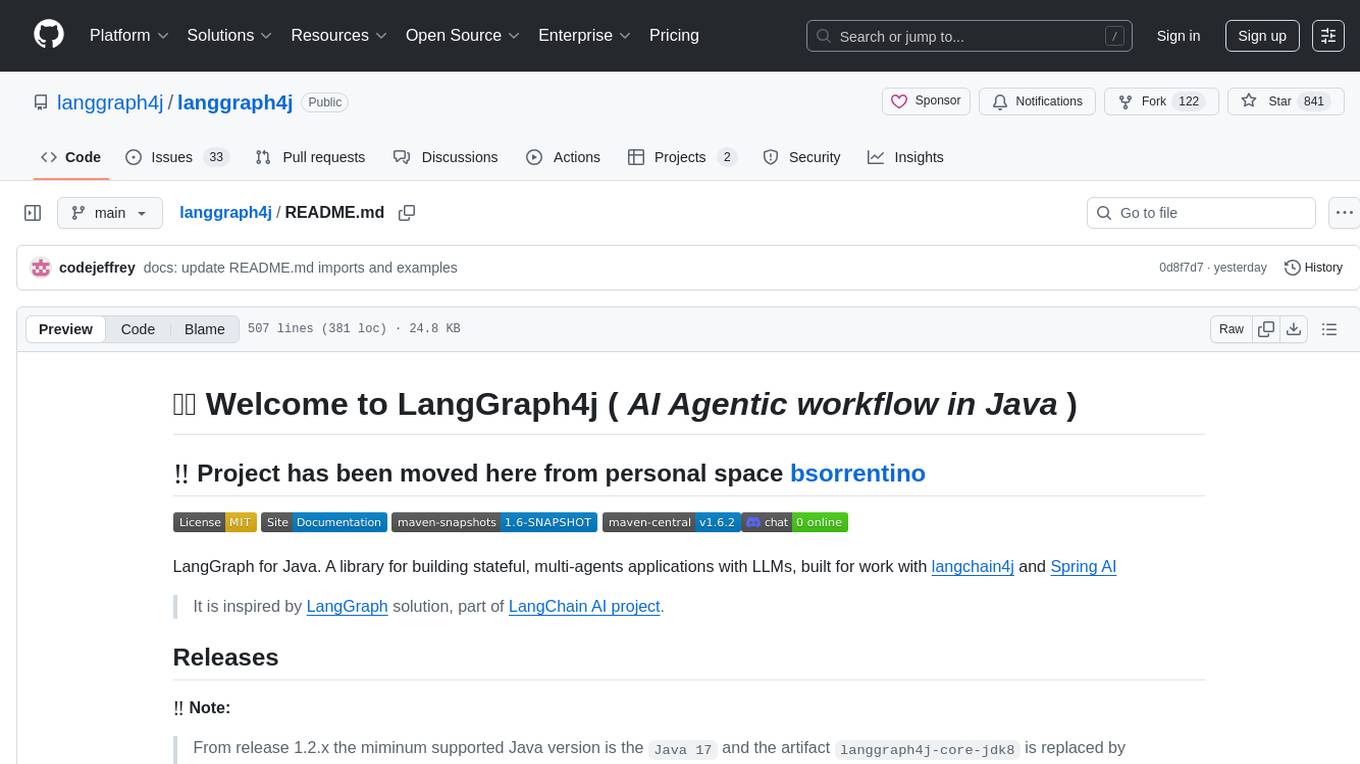
langgraph4j
Langgraph4j is a Java library for language processing tasks such as text classification, sentiment analysis, and named entity recognition. It provides a set of tools and algorithms for analyzing text data and extracting useful information. The library is designed to be efficient and easy to use, making it suitable for both research and production applications.
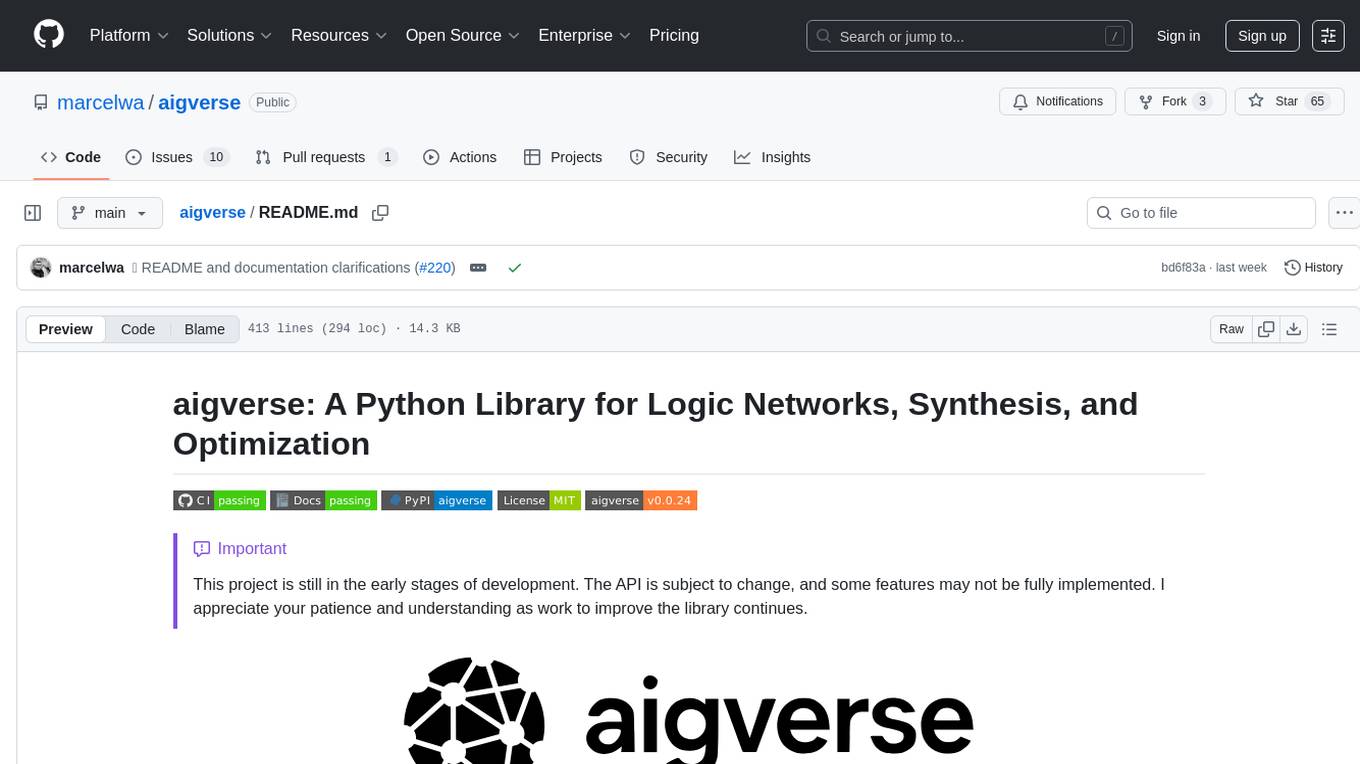
aigverse
aigverse is a Python infrastructure framework that bridges the gap between logic synthesis and AI/ML applications. It allows efficient representation and manipulation of logic circuits, making it easier to integrate logic synthesis and optimization tasks into machine learning pipelines. Built upon EPFL Logic Synthesis Libraries, particularly mockturtle, aigverse provides a high-level Python interface to state-of-the-art algorithms for And-Inverter Graph (AIG) manipulation and logic synthesis, widely used in formal verification, hardware design, and optimization tasks.
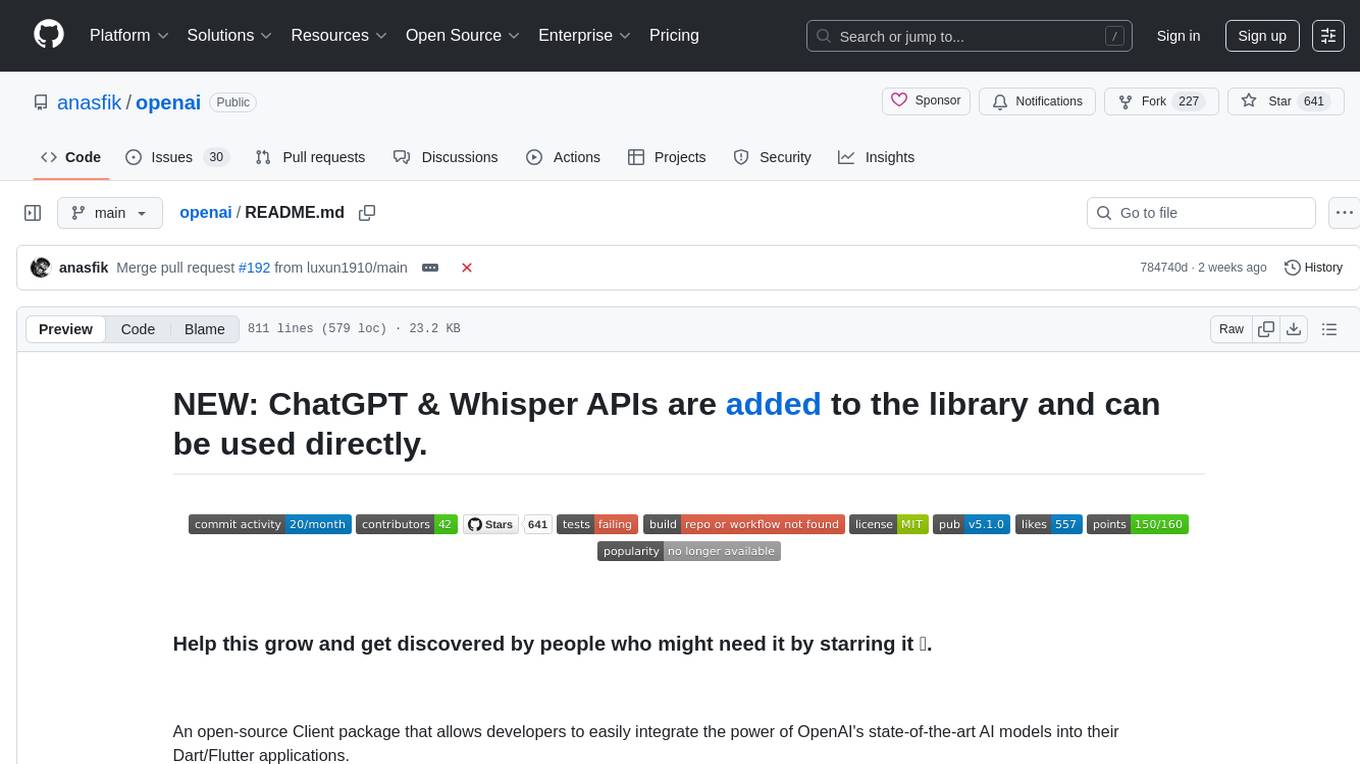
openai
An open-source client package that allows developers to easily integrate the power of OpenAI's state-of-the-art AI models into their Dart/Flutter applications. The library provides simple and intuitive methods for making requests to OpenAI's various APIs, including the GPT-3 language model, DALL-E image generation, and more. It is designed to be lightweight and easy to use, enabling developers to focus on building their applications without worrying about the complexities of dealing with HTTP requests. Note that this is an unofficial library as OpenAI does not have an official Dart library.
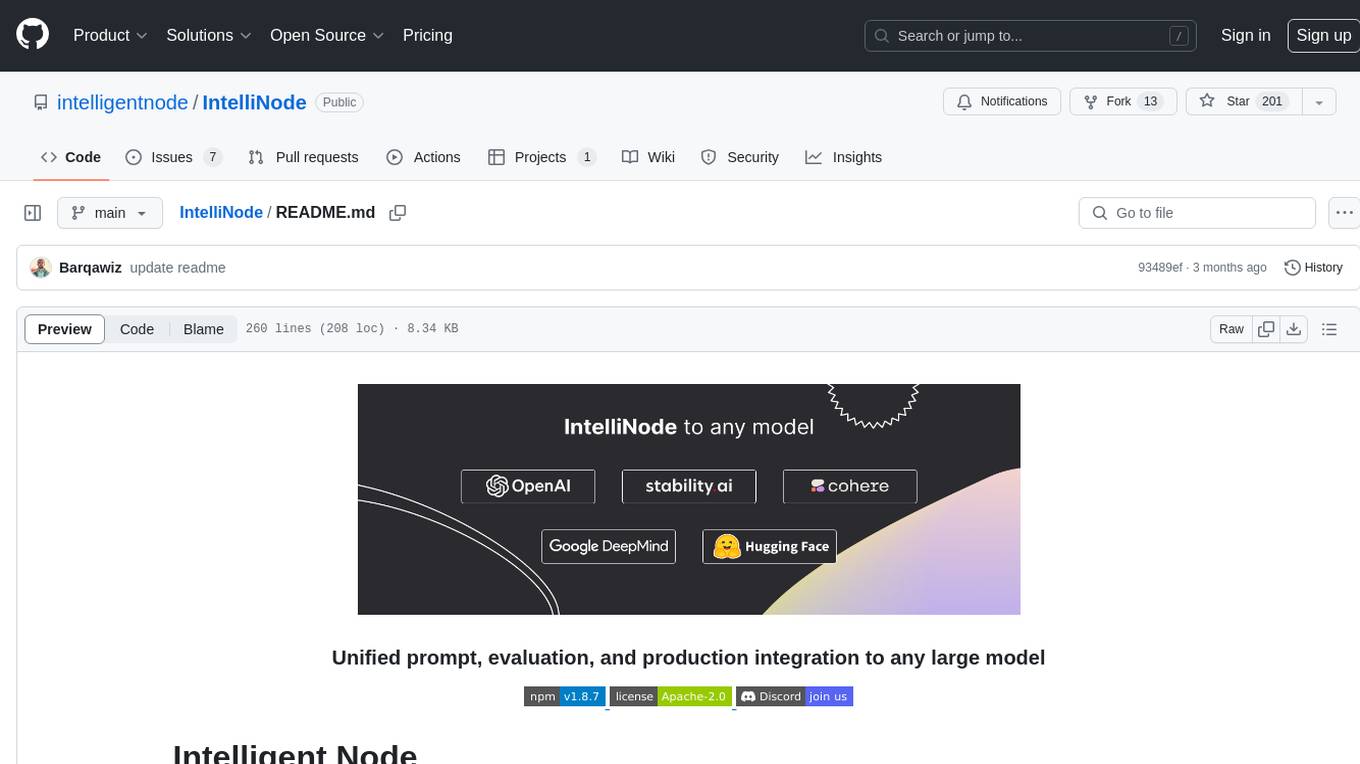
IntelliNode
IntelliNode is a javascript module that integrates cutting-edge AI models like ChatGPT, LLaMA, WaveNet, Gemini, and Stable diffusion into projects. It offers functions for generating text, speech, and images, as well as semantic search, multi-model evaluation, and chatbot capabilities. The module provides a wrapper layer for low-level model access, a controller layer for unified input handling, and a function layer for abstract functionality tailored to various use cases.
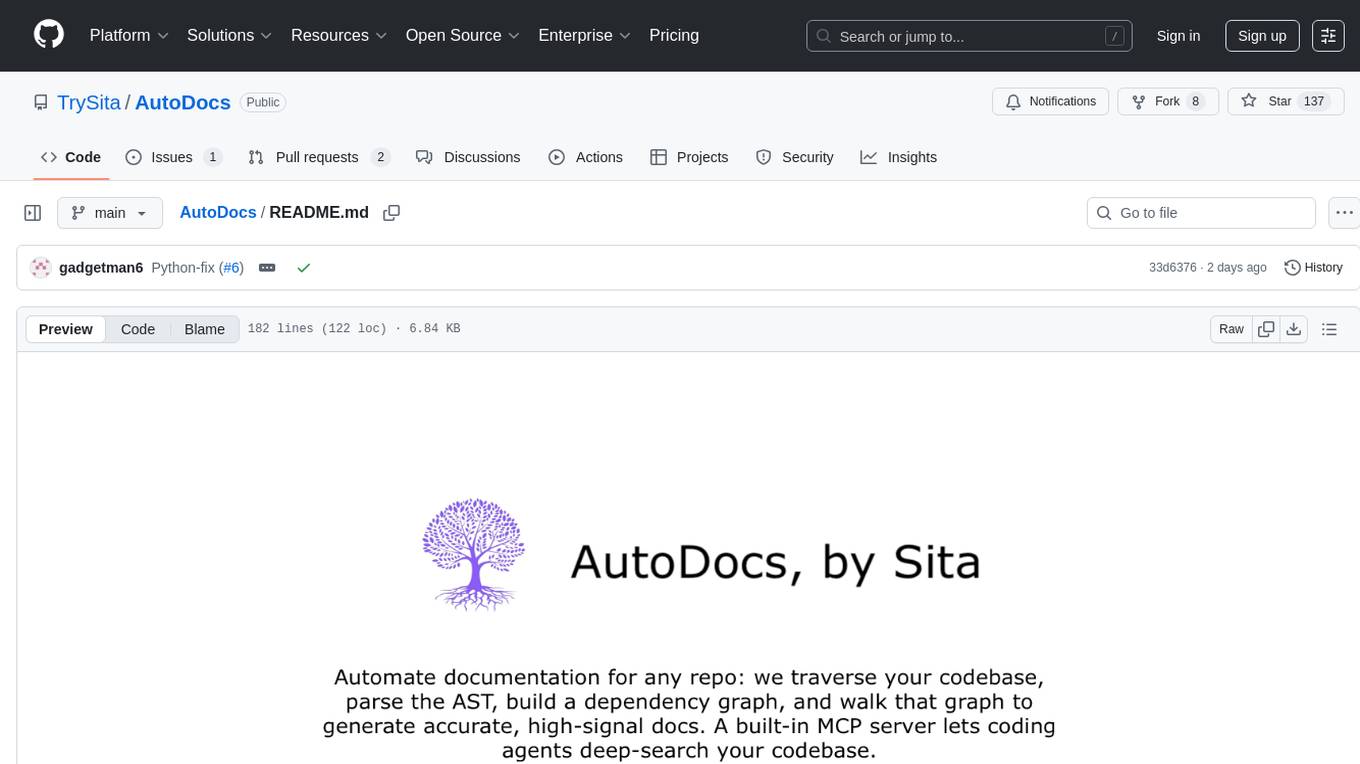
AutoDocs
AutoDocs by Sita is a tool designed to automate documentation for any repository. It parses the repository using tree-sitter and SCIP, constructs a code dependency graph, and generates repository-wide, dependency-aware documentation and summaries. It provides a FastAPI backend for ingestion/search and a Next.js web UI for chat and exploration. Additionally, it includes an MCP server for deep search capabilities. The tool aims to simplify the process of generating accurate and high-signal documentation for codebases.
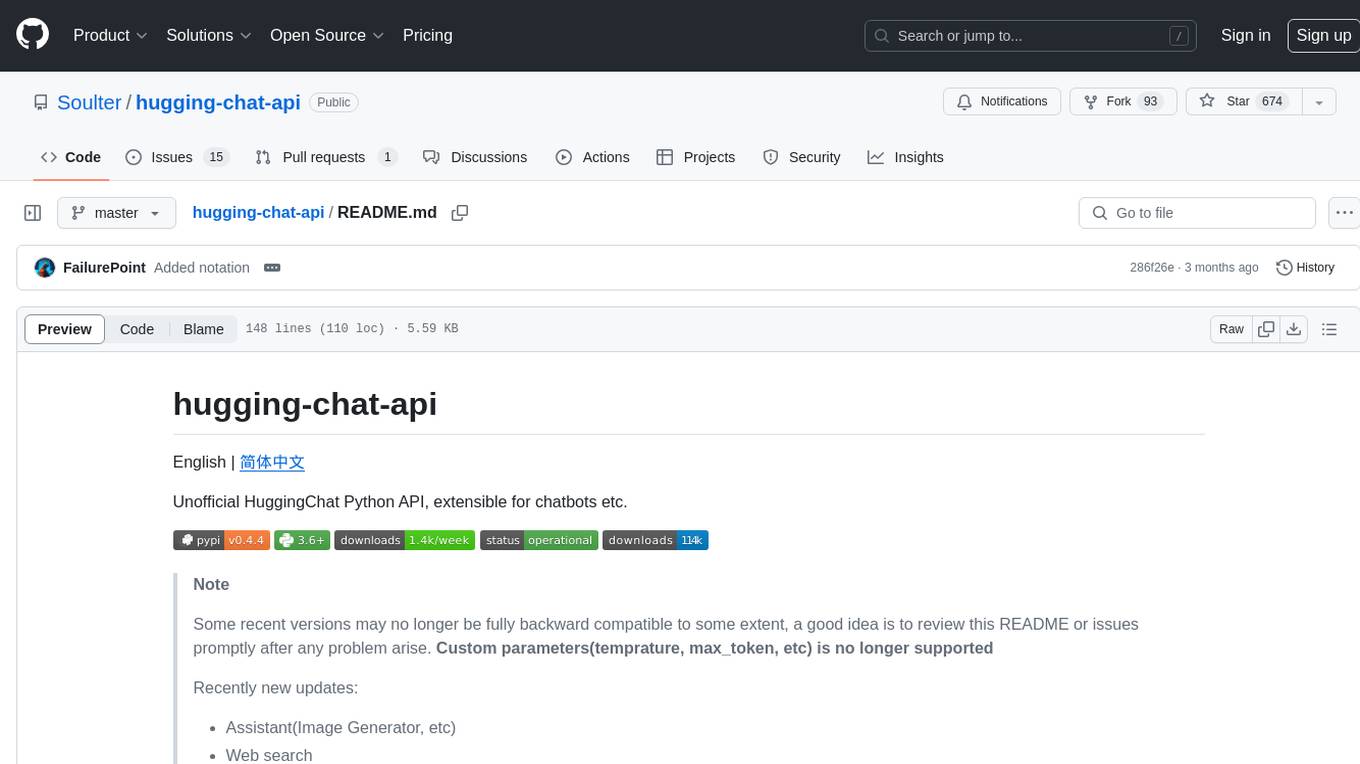
hugging-chat-api
Unofficial HuggingChat Python API for creating chatbots, supporting features like image generation, web search, memorizing context, and changing LLMs. Users can log in, chat with the ChatBot, perform web searches, create new conversations, manage conversations, switch models, get conversation info, use assistants, and delete conversations. The API also includes a CLI mode with various commands for interacting with the tool. Users are advised not to use the application for high-stakes decisions or advice and to avoid high-frequency requests to preserve server resources.
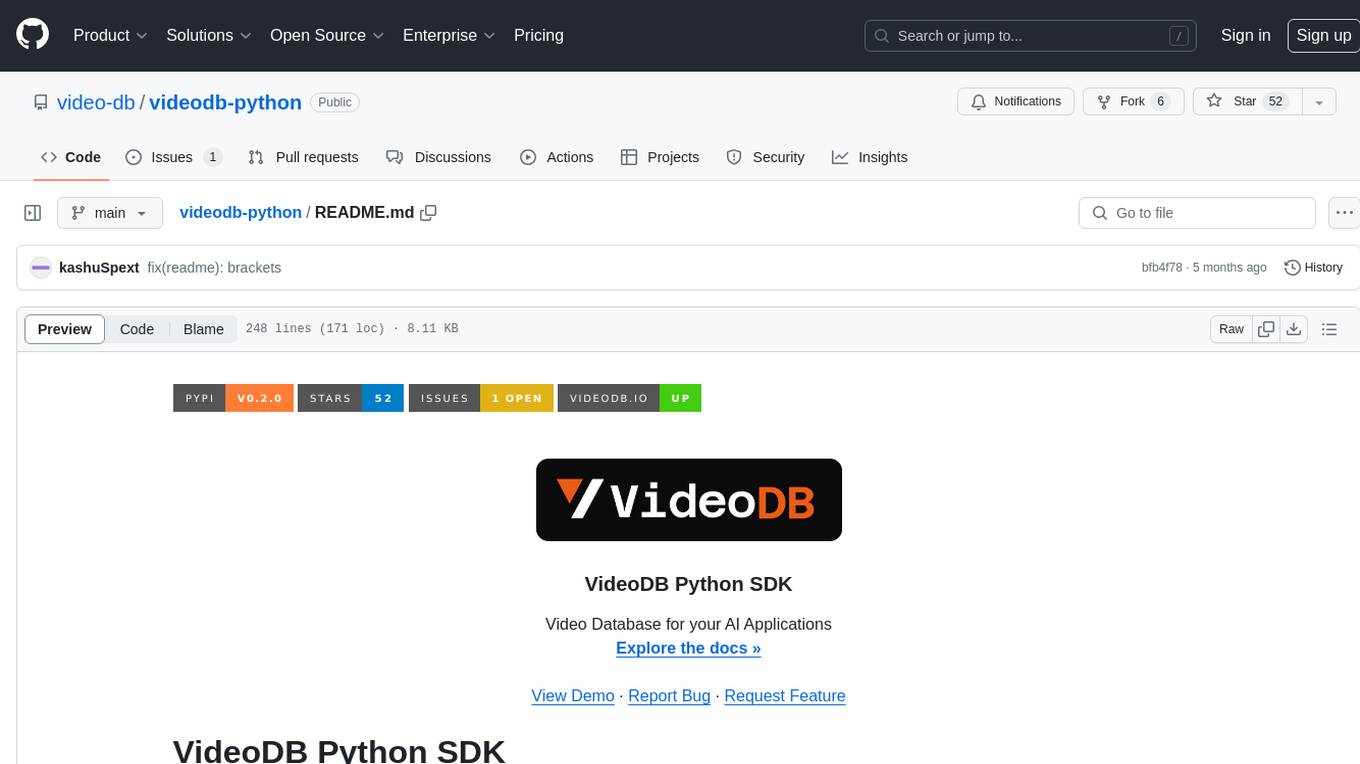
videodb-python
VideoDB Python SDK allows you to interact with the VideoDB serverless database. Manage videos as intelligent data, not files. It's scalable, cost-efficient & optimized for AI applications and LLM integration. The SDK provides functionalities for uploading videos, viewing videos, streaming specific sections of videos, searching inside a video, searching inside multiple videos in a collection, adding subtitles to a video, generating thumbnails, and more. It also offers features like indexing videos by spoken words, semantic indexing, and future indexing options for scenes, faces, and specific domains like sports. The SDK aims to simplify video management and enhance AI applications with video data.
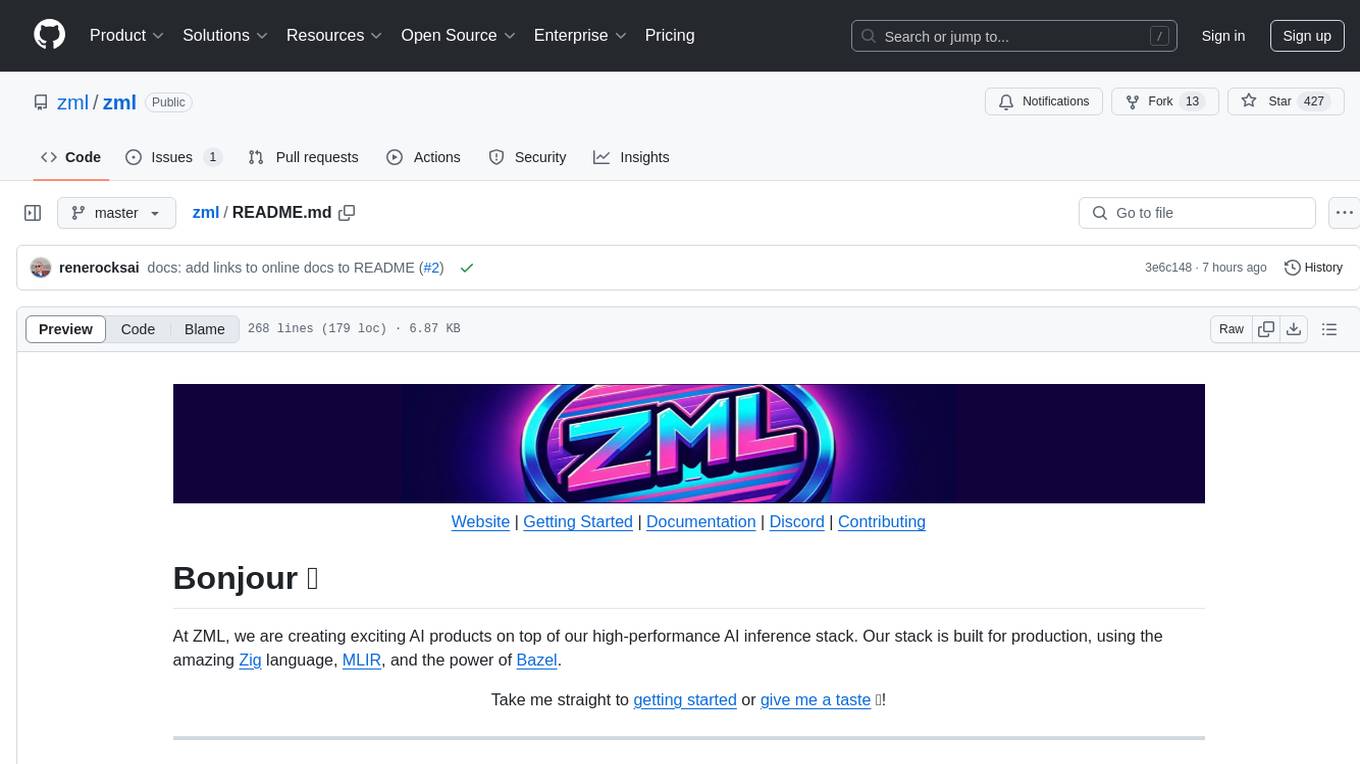
zml
ZML is a high-performance AI inference stack built for production, using Zig language, MLIR, and Bazel. It allows users to create exciting AI projects, run pre-packaged models like MNIST, TinyLlama, OpenLLama, and Meta Llama, and compile models for accelerator runtimes. Users can also run tests, explore examples, and contribute to the project. ZML is licensed under the Apache 2.0 license.
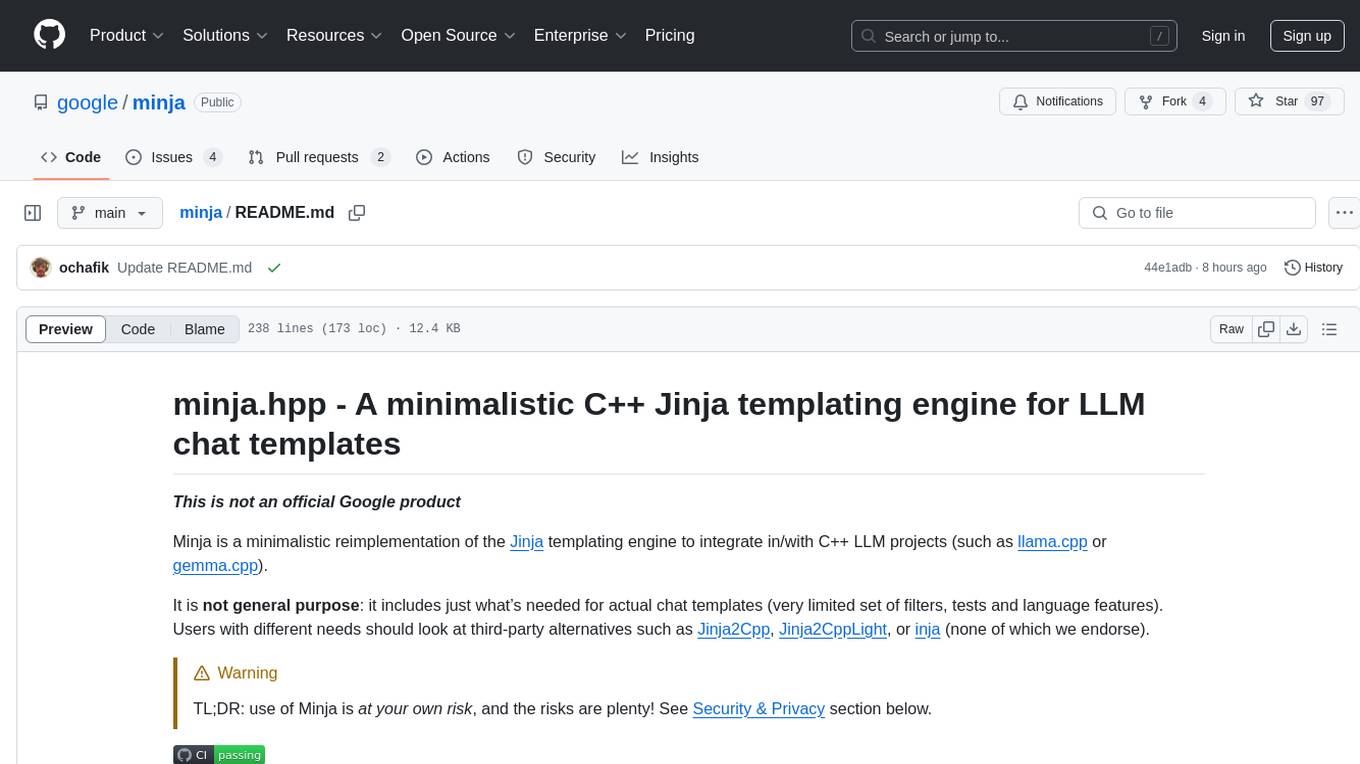
minja
Minja is a minimalistic C++ Jinja templating engine designed specifically for integration with C++ LLM projects, such as llama.cpp or gemma.cpp. It is not a general-purpose tool but focuses on providing a limited set of filters, tests, and language features tailored for chat templates. The library is header-only, requires C++17, and depends only on nlohmann::json. Minja aims to keep the codebase small, easy to understand, and offers decent performance compared to Python. Users should be cautious when using Minja due to potential security risks, and it is not intended for producing HTML or JavaScript output.
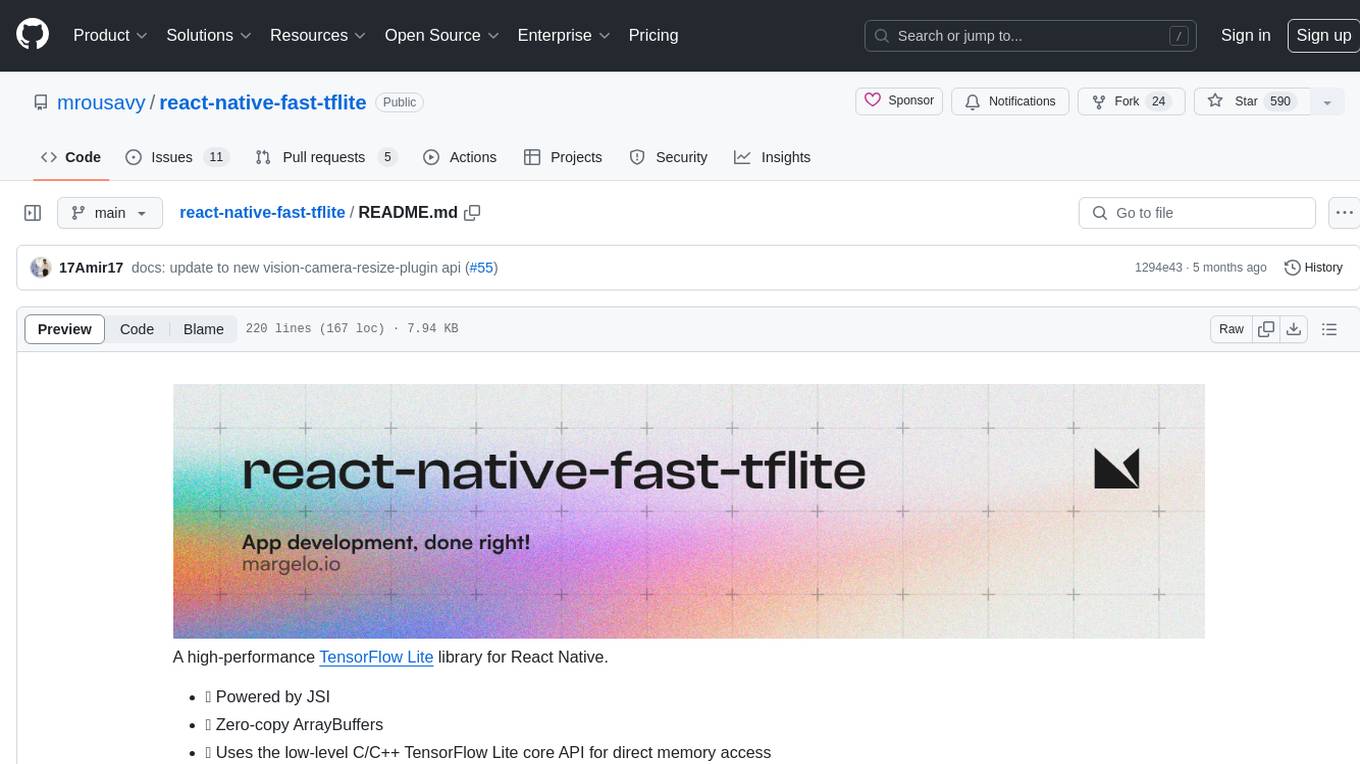
react-native-fast-tflite
A high-performance TensorFlow Lite library for React Native that utilizes JSI for power, zero-copy ArrayBuffers for efficiency, and low-level C/C++ TensorFlow Lite core API for direct memory access. It supports swapping out TensorFlow Models at runtime and GPU-accelerated delegates like CoreML/Metal/OpenGL. Easy VisionCamera integration allows for seamless usage. Users can load TensorFlow Lite models, interpret input and output data, and utilize GPU Delegates for faster computation. The library is suitable for real-time object detection, image classification, and other machine learning tasks in React Native applications.
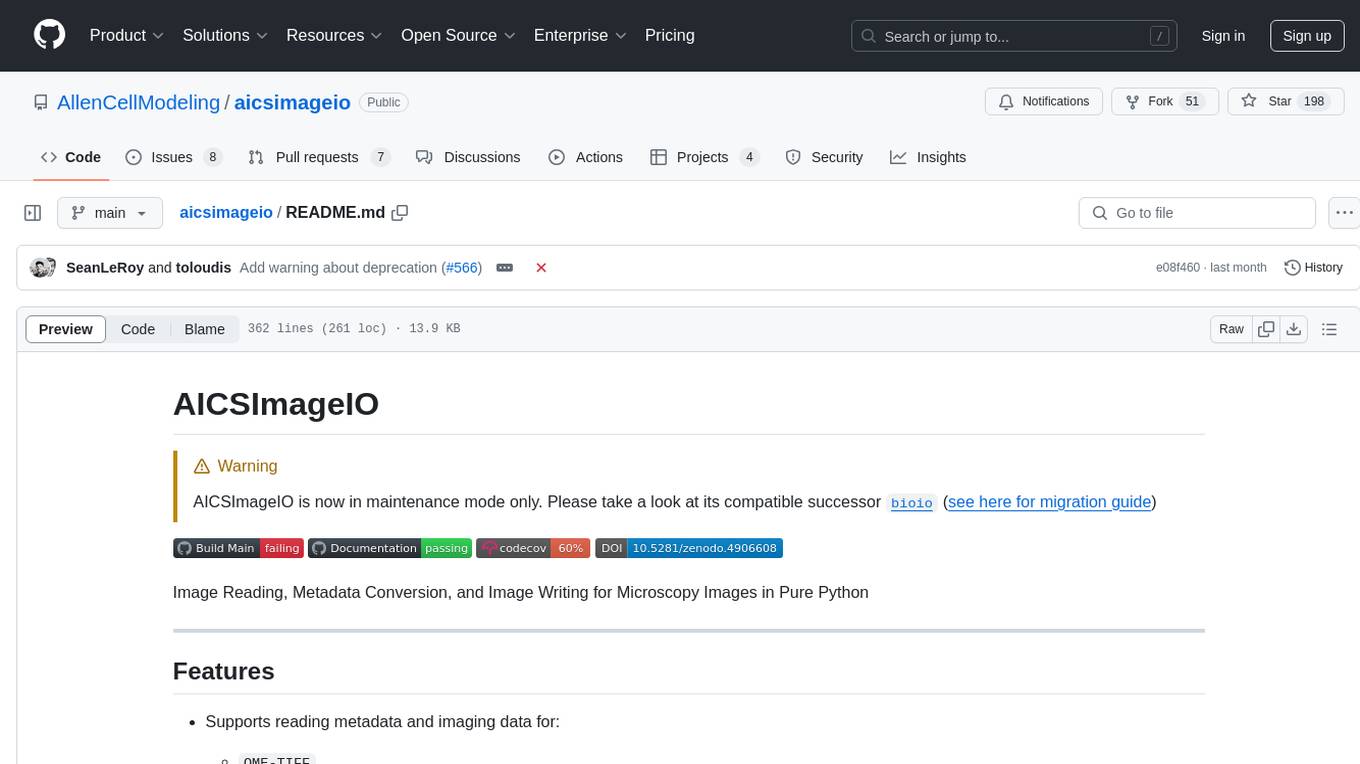
aicsimageio
AICSImageIO is a Python tool for Image Reading, Metadata Conversion, and Image Writing for Microscopy Images. It supports various file formats like OME-TIFF, TIFF, ND2, DV, CZI, LIF, PNG, GIF, and Bio-Formats. Users can read and write metadata and imaging data, work with different file systems like local paths, HTTP URLs, s3fs, and gcsfs. The tool provides functionalities for full image reading, delayed image reading, mosaic image reading, metadata reading, xarray coordinate plane attachment, cloud IO support, and saving to OME-TIFF. It also offers benchmarking and developer resources.
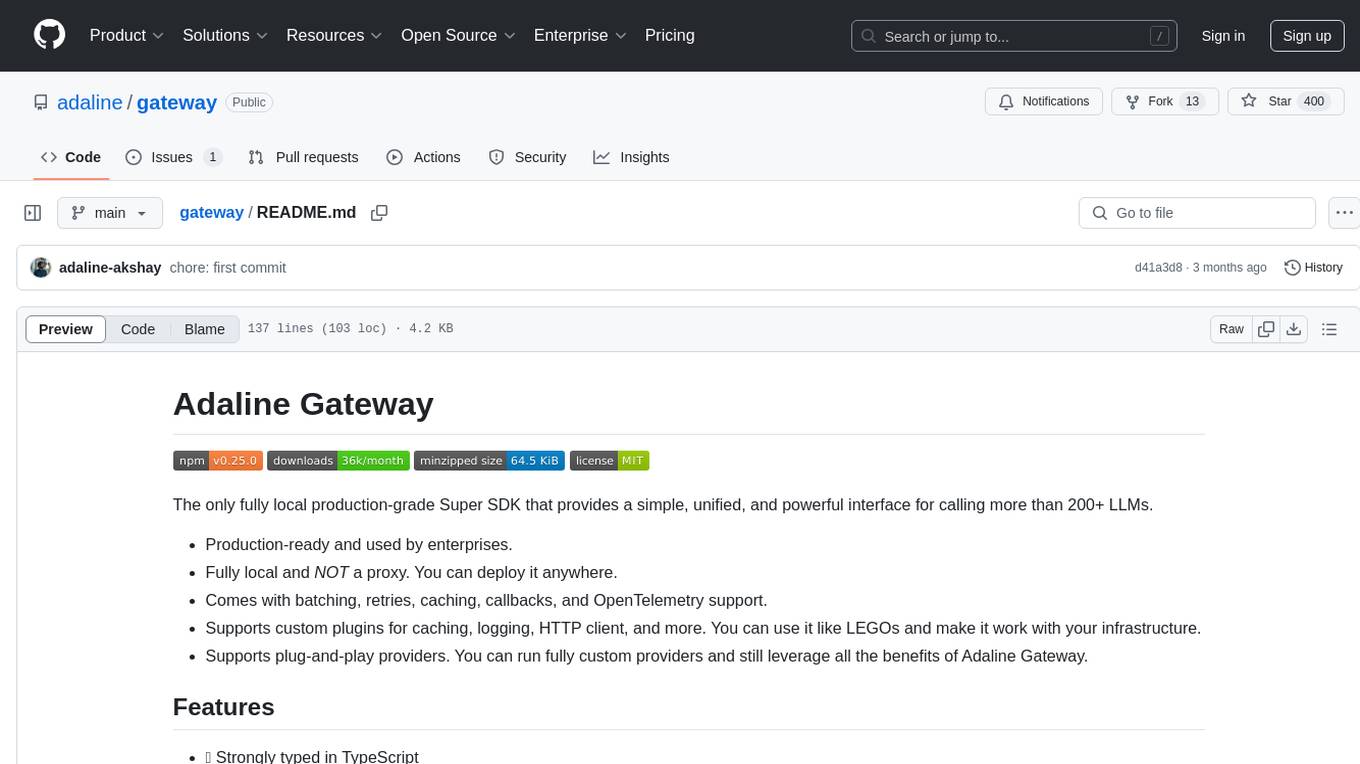
gateway
Adaline Gateway is a fully local production-grade Super SDK that offers a unified interface for calling over 200+ LLMs. It is production-ready, supports batching, retries, caching, callbacks, and OpenTelemetry. Users can create custom plugins and providers for seamless integration with their infrastructure.
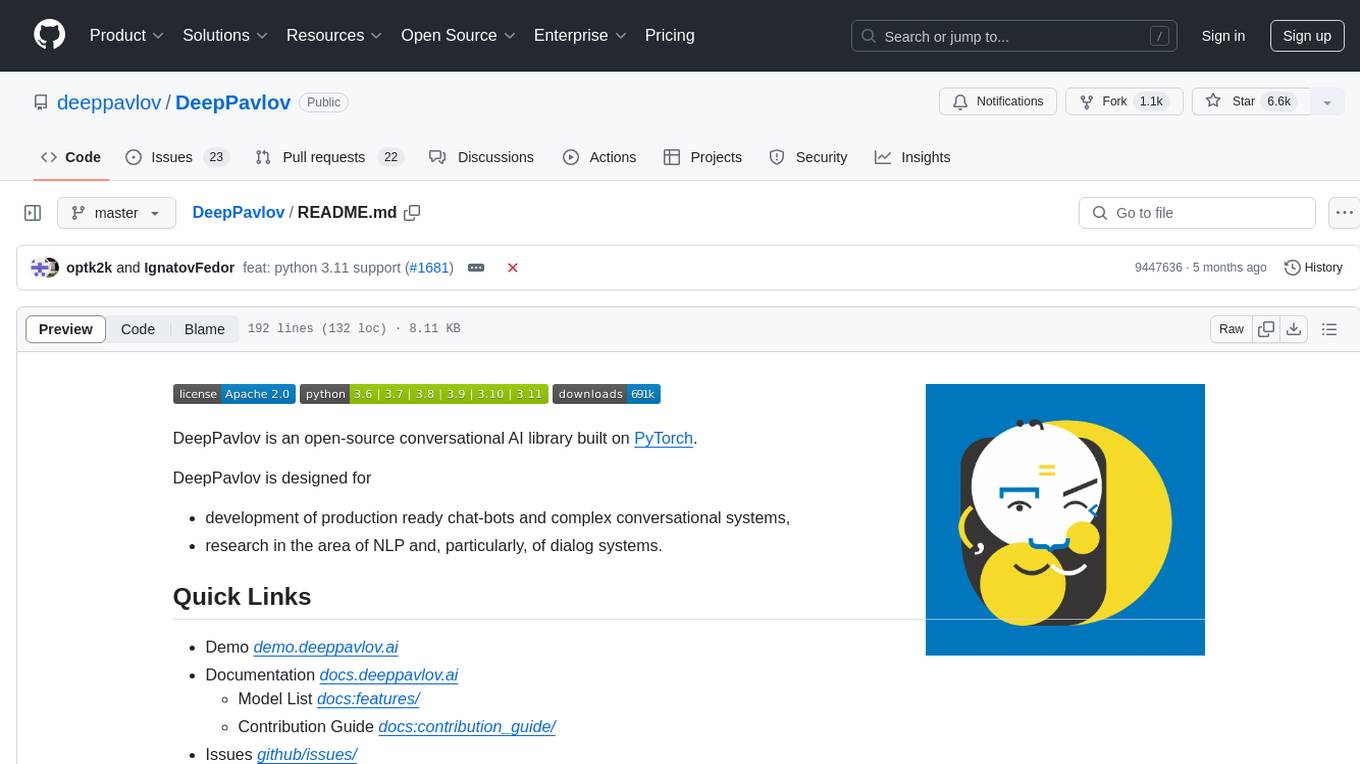
DeepPavlov
DeepPavlov is an open-source conversational AI library built on PyTorch. It is designed for the development of production-ready chatbots and complex conversational systems, as well as for research in the area of NLP and dialog systems. The library offers a wide range of models for tasks such as Named Entity Recognition, Intent/Sentence Classification, Question Answering, Sentence Similarity/Ranking, Syntactic Parsing, and more. DeepPavlov also provides embeddings like BERT, ELMo, and FastText for various languages, along with AutoML capabilities and integrations with REST API, Socket API, and Amazon AWS.

generative-ai
The 'Generative AI' repository provides a C# library for interacting with Google's Generative AI models, specifically the Gemini models. It allows users to access and integrate the Gemini API into .NET applications, supporting functionalities such as listing available models, generating content, creating tuned models, working with large files, starting chat sessions, and more. The repository also includes helper classes and enums for Gemini API aspects. Authentication methods include API key, OAuth, and various authentication modes for Google AI and Vertex AI. The package offers features for both Google AI Studio and Google Cloud Vertex AI, with detailed instructions on installation, usage, and troubleshooting.
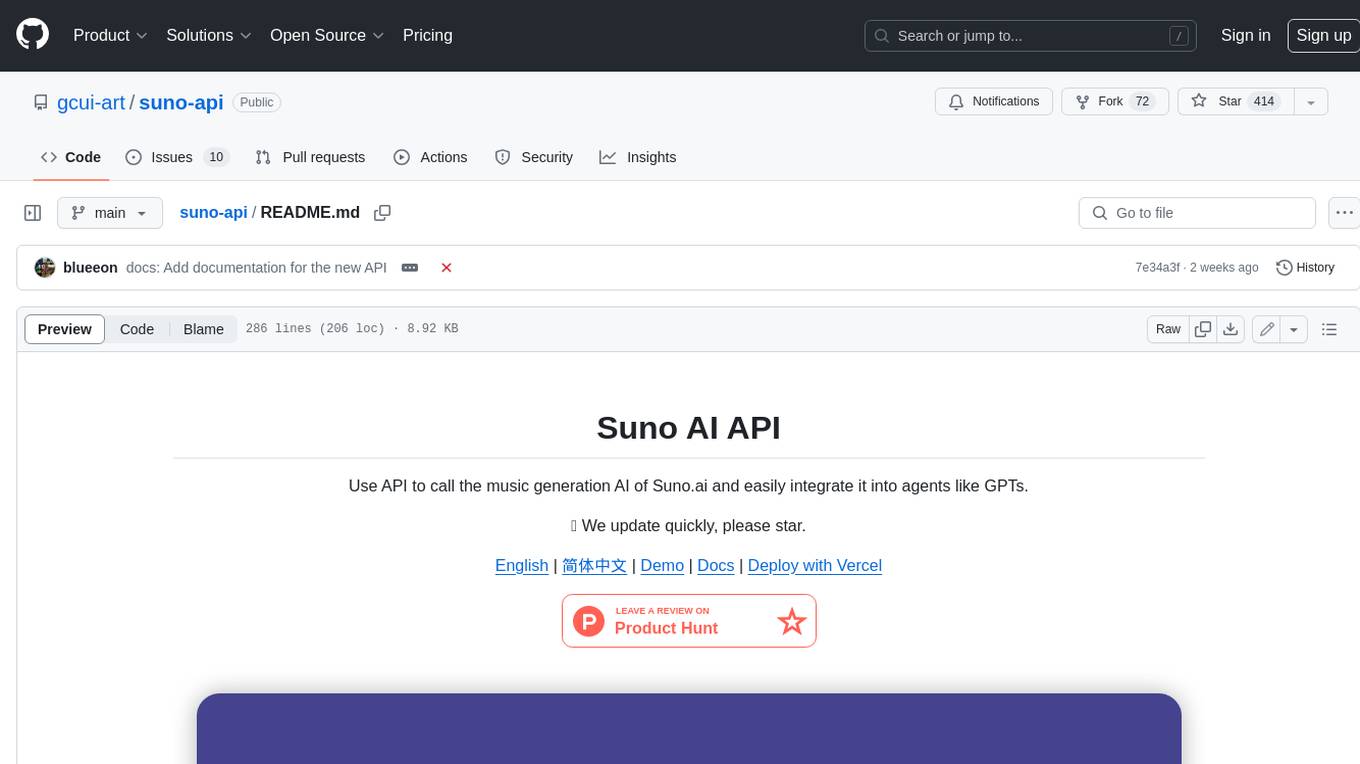
suno-api
Suno AI API is an open-source project that allows developers to integrate the music generation capabilities of Suno.ai into their own applications. The API provides a simple and convenient way to generate music, lyrics, and other audio content using Suno.ai's powerful AI models. With Suno AI API, developers can easily add music generation functionality to their apps, websites, and other projects.
For similar tasks

Aiwnios
Aiwnios is a HolyC Compiler/Runtime designed for 64-bit ARM, RISCV, and x86 machines, including Apple M1 Macs, with plans for supporting other architectures in the future. The project is currently a work in progress, with regular updates and improvements planned. Aiwnios includes a sockets API (currently tested on FreeBSD) and a HolyC assembler accessible through AARCH64. The heart of Aiwnios lies in `arm_backend.c`, where the compiler is located, and a powerful AARCH64 assembler in `arm64_asm.c`. The compiler uses reverse Polish notation and statements are reversed. The developer manual is intended for developers working on the C side, providing detailed explanations of the source code.

llm_processes
This repository contains code for LLM Processes, which focuses on generating numerical predictive distributions conditioned on natural language. It supports various LLMs through Hugging Face transformer APIs and includes experiments on prompt engineering, 1D synthetic data, comparison to LLMTime, Fashion MNIST, black-box optimization, weather regression, in-context learning, and text conditioning. The code requires Python 3.9+, PyTorch 2.3.0+, and other dependencies for running experiments and reproducing results.
For similar jobs

Aiwnios
Aiwnios is a HolyC Compiler/Runtime designed for 64-bit ARM, RISCV, and x86 machines, including Apple M1 Macs, with plans for supporting other architectures in the future. The project is currently a work in progress, with regular updates and improvements planned. Aiwnios includes a sockets API (currently tested on FreeBSD) and a HolyC assembler accessible through AARCH64. The heart of Aiwnios lies in `arm_backend.c`, where the compiler is located, and a powerful AARCH64 assembler in `arm64_asm.c`. The compiler uses reverse Polish notation and statements are reversed. The developer manual is intended for developers working on the C side, providing detailed explanations of the source code.
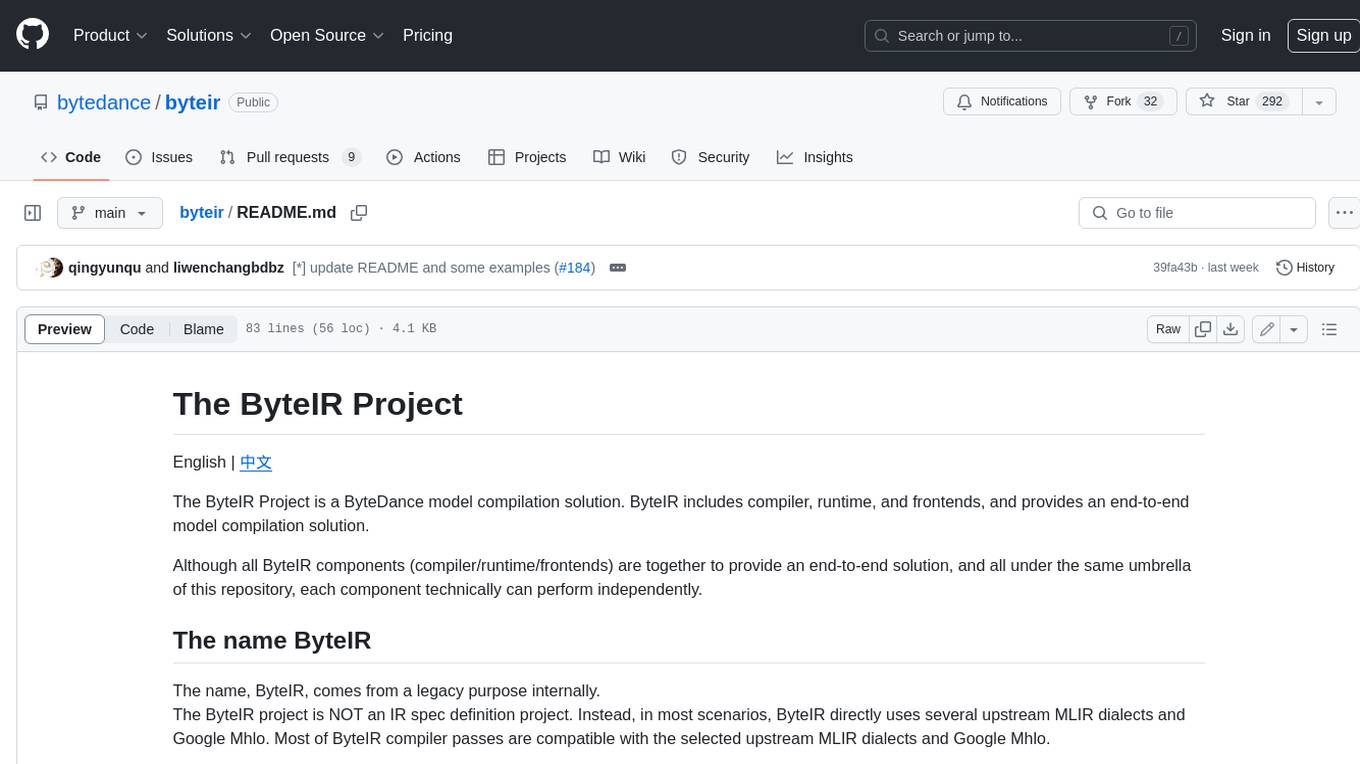
byteir
The ByteIR Project is a ByteDance model compilation solution. ByteIR includes compiler, runtime, and frontends, and provides an end-to-end model compilation solution. Although all ByteIR components (compiler/runtime/frontends) are together to provide an end-to-end solution, and all under the same umbrella of this repository, each component technically can perform independently. The name, ByteIR, comes from a legacy purpose internally. The ByteIR project is NOT an IR spec definition project. Instead, in most scenarios, ByteIR directly uses several upstream MLIR dialects and Google Mhlo. Most of ByteIR compiler passes are compatible with the selected upstream MLIR dialects and Google Mhlo.
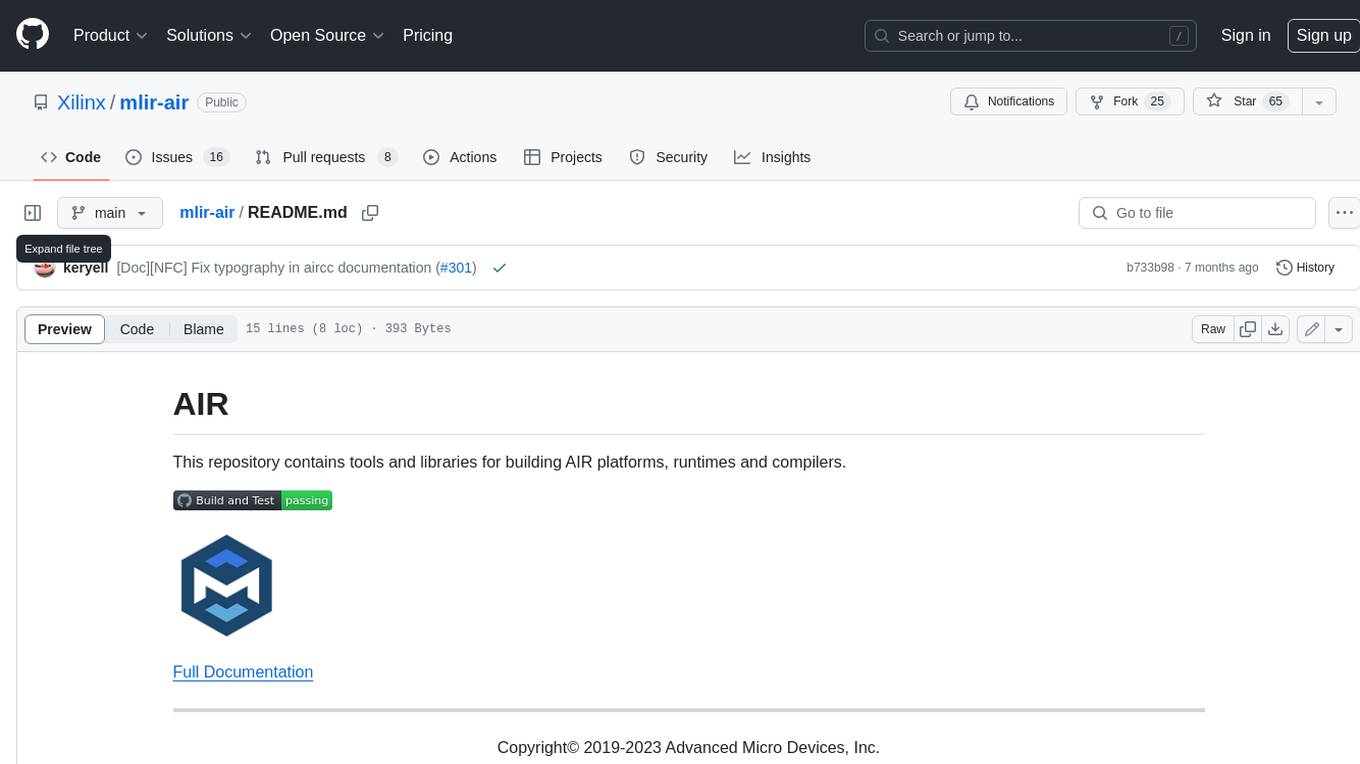
mlir-air
This repository contains tools and libraries for building AIR platforms, runtimes and compilers.
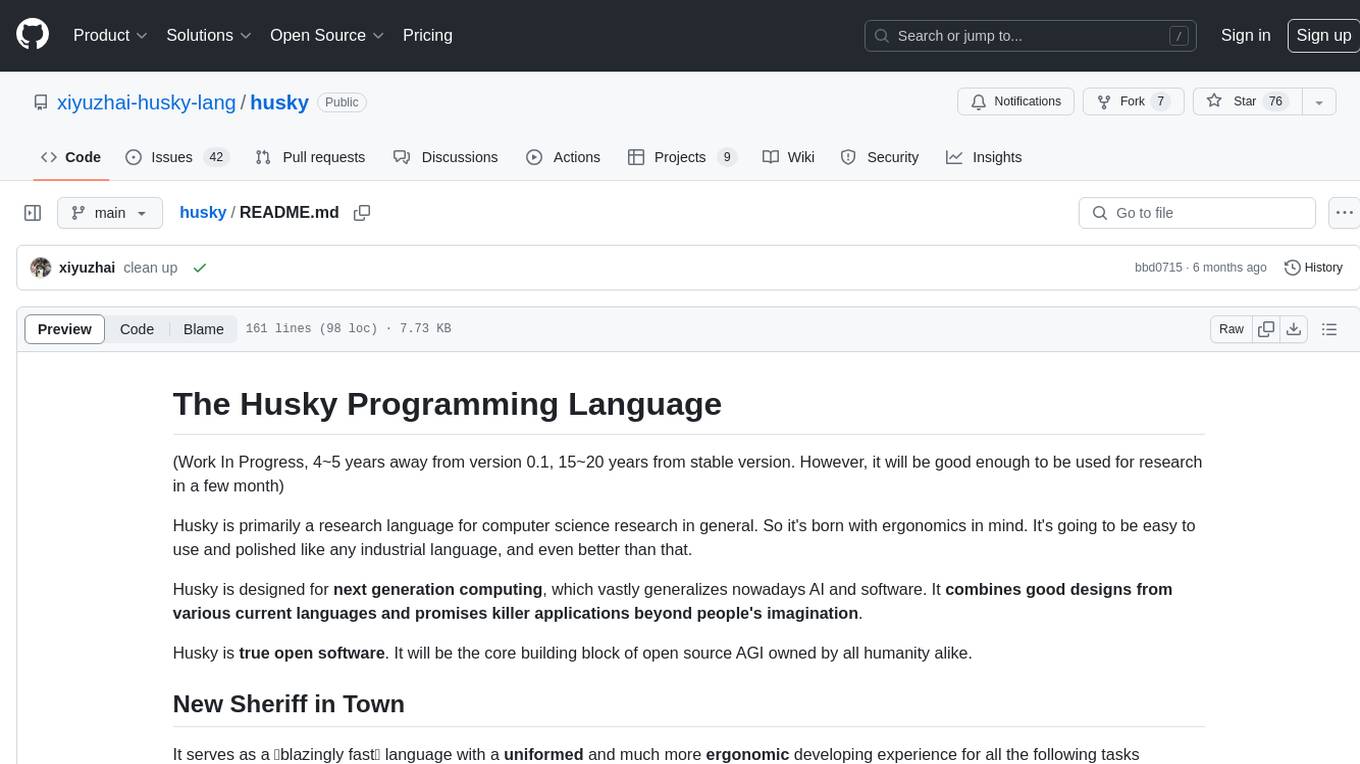
husky
Husky is a research-focused programming language designed for next-generation computing. It aims to provide a powerful and ergonomic development experience for various tasks, including system level programming, web/native frontend development, parser/compiler tasks, game development, formal verification, machine learning, and more. With a strong type system and support for human-in-the-loop programming, Husky enables users to tackle complex tasks such as explainable image classification, natural language processing, and reinforcement learning. The language prioritizes debugging, visualization, and human-computer interaction, offering agile compilation and evaluation, multiparadigm support, and a commitment to a good ecosystem.
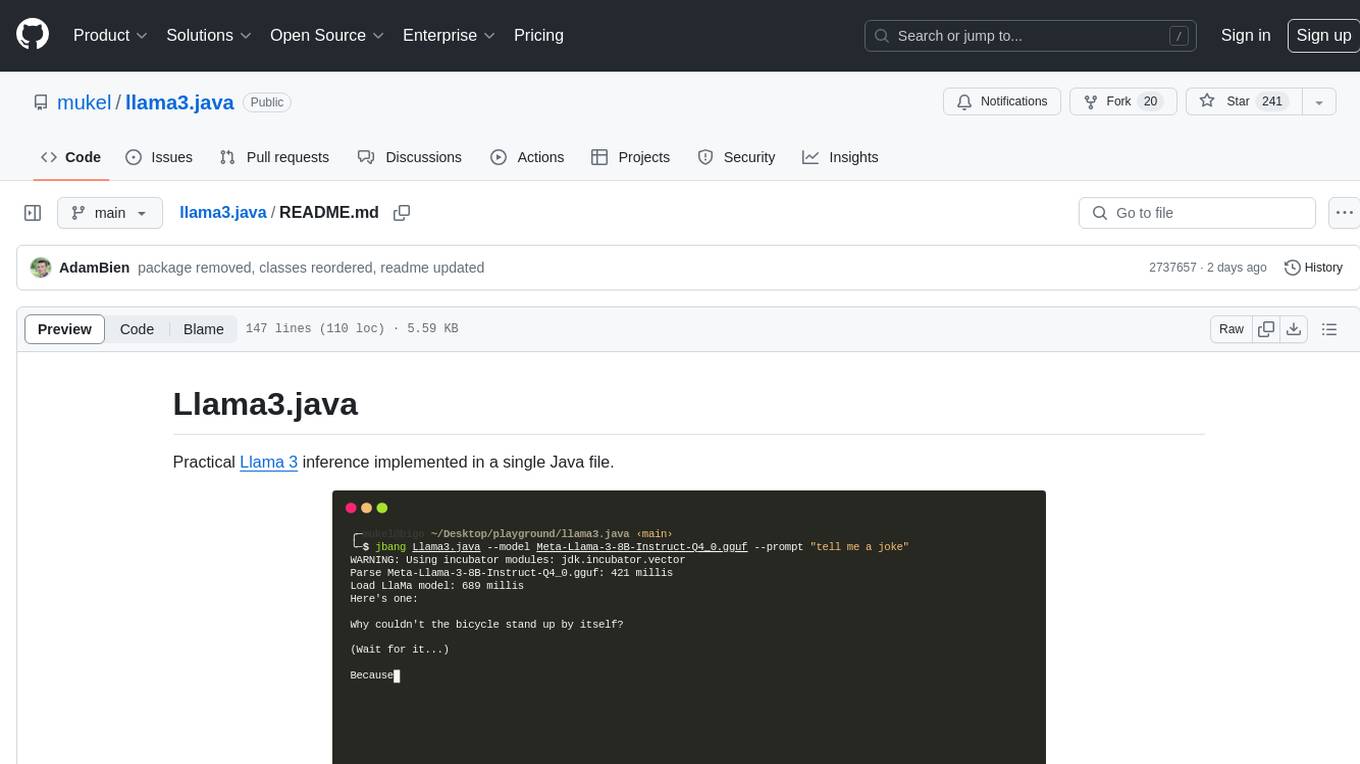
llama3.java
Llama3.java is a practical Llama 3 inference tool implemented in a single Java file. It serves as the successor of llama2.java and is designed for testing and tuning compiler optimizations and features on the JVM, especially for the Graal compiler. The tool features a GGUF format parser, Llama 3 tokenizer, Grouped-Query Attention inference, support for Q8_0 and Q4_0 quantizations, fast matrix-vector multiplication routines using Java's Vector API, and a simple CLI with 'chat' and 'instruct' modes. Users can download quantized .gguf files from huggingface.co for model usage and can also manually quantize to pure 'Q4_0'. The tool requires Java 21+ and supports running from source or building a JAR file for execution. Performance benchmarks show varying tokens/s rates for different models and implementations on different hardware setups.
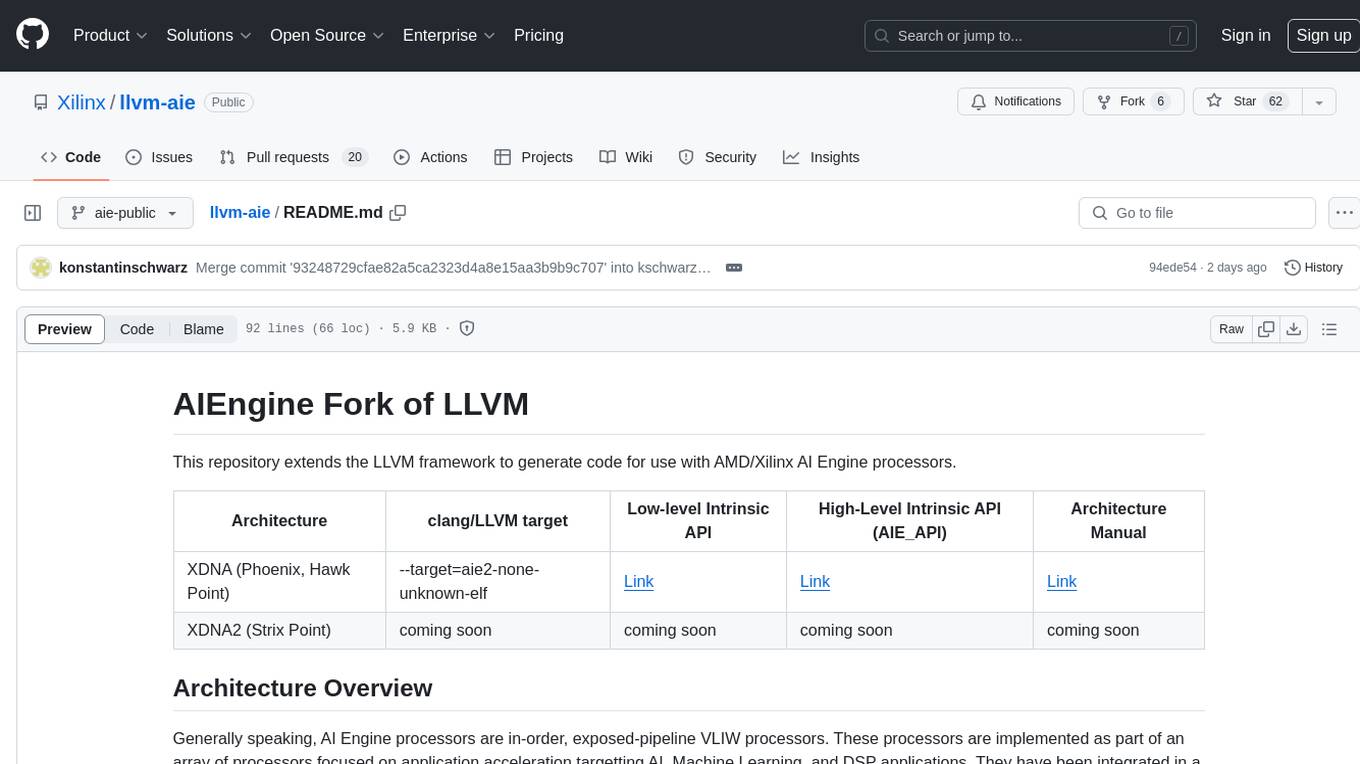
llvm-aie
This repository extends the LLVM framework to generate code for use with AMD/Xilinx AI Engine processors. AI Engine processors are in-order, exposed-pipeline VLIW processors focused on application acceleration for AI, Machine Learning, and DSP applications. The repository adds LLVM support for specific features like non-power of 2 pointers, operand latencies, resource conflicts, negative operand latencies, slot assignment, relocations, code alignment restrictions, and register allocation. It includes support for Clang, LLD, binutils, Compiler-RT, and LLVM-LIBC.
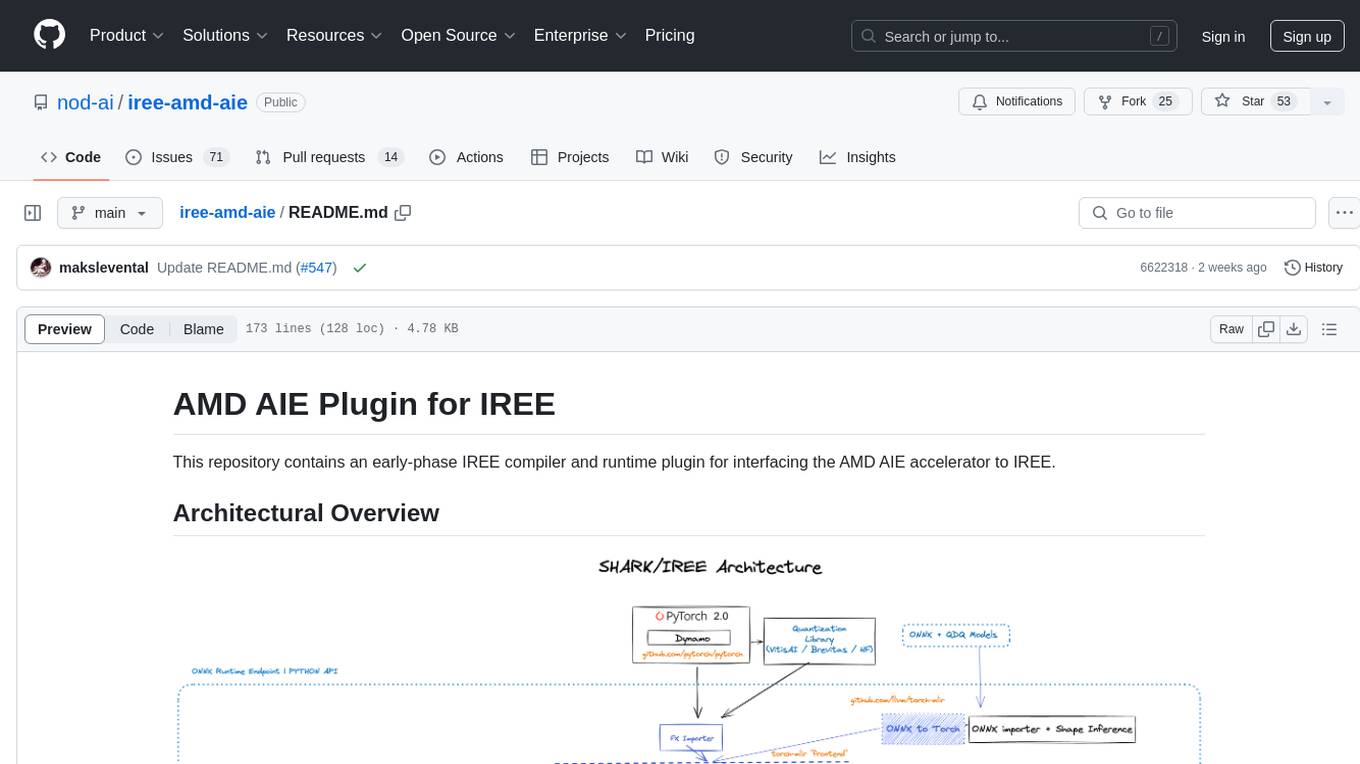
iree-amd-aie
This repository contains an early-phase IREE compiler and runtime plugin for interfacing the AMD AIE accelerator to IREE. It provides architectural overview, developer setup instructions, building guidelines, and runtime driver setup details. The repository focuses on enabling the integration of the AMD AIE accelerator with IREE, offering developers the tools and resources needed to build and run applications leveraging this technology.
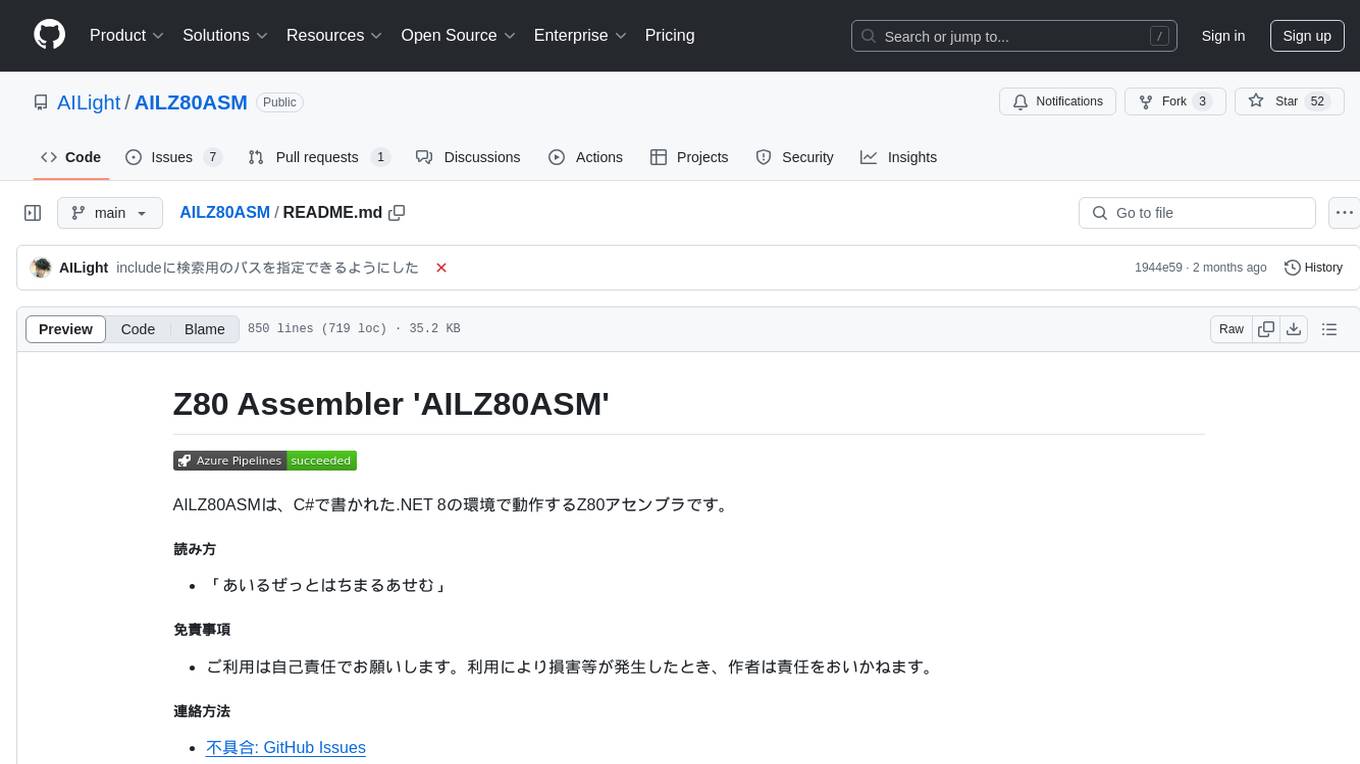
AILZ80ASM
AILZ80ASM is a Z80 assembler that runs in a .NET 8 environment written in C#. It can be used to assemble Z80 assembly code and generate output files in various formats. The tool supports various command-line options for customization and provides features like macros, conditional assembly, and error checking. AILZ80ASM offers good performance metrics with fast assembly times and efficient output file sizes. It also includes support for handling different file encodings and provides a range of built-in functions for working with labels, expressions, and data types.

